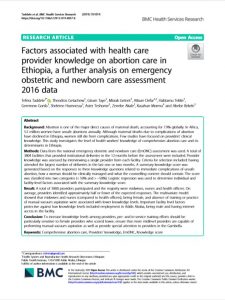
Background
Abortion is one of the major direct causes of maternal death, accounting for 7.9% globally. In Africa, 5.5 million women have unsafe abortions annually. Although maternal deaths due to complications of abortion have declined in Ethiopia, women still die from complications. Few studies have focused on providers’ clinical knowledge. This study investigates the level of health workers’ knowledge of comprehensive abortion care and its determinants in Ethiopia.
Methods
Data from the national emergency obstetric and newborn care (EmONC) assessment was used. A total of 3804 facilities that provided institutional deliveries in the 12 months before the assessment were included. Provider knowledge was assessed by interviewing a single provider from each facility. Criteria for selection included: having attended the largest number of deliveries in the last one or two months. A summary knowledge score was generated based on the responses to three knowledge questions related to immediate complications of unsafe abortion, how a woman should be clinically managed and what the counselling content should contain. The score was classified into two categories (< 50% and > =50%). Logistic regression was used to determine individual and facility-level factors associated with the summary knowledge score.
Result
A total of 3800 providers participated and the majority were midwives, nurses and health officers. On average, providers identified approximately half or fewer of the expected responses. The multivariate model showed that midwives and nurses (compared to health officers), being female, and absence of training or practice of manual vacuum aspiration were associated with lower knowledge levels. Important facility level factors protective against low knowledge levels included employment in Addis Ababa, being male and having internet access in the facility.
Conclusion
To increase knowledge levels among providers, pre- and in-service training efforts should be particularly sensitive to female providers who scored lower, ensure that more midlevel providers are capable of performing manual vacuum aspiration as well as provide special attention to providers in the Gambella.